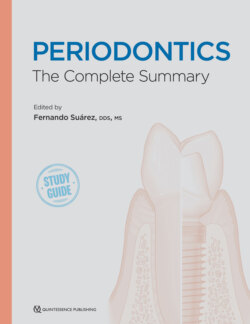Читать книгу Periodontics - Fernando Suarez - Страница 95
На сайте Литреса книга снята с продажи.
Root Morphology ROOT SURFACE AREA
ОглавлениеRoot surface area has been extensively explored in the literature (Table 5-6).104–108 While initially investigated as an important factor to aid clinicians in decision making for root resection therapy,13 the calculation of this area is also helpful to determine the extent of disease progression and to assist in the selection between regenerative or resective approaches.
TABLE 5-6 Average root surface area (mm2) covered by cementum*
*Adapted from Schroeder.108
Hermann et al13 reported a total surface area for the maxillary first molar of 476.43 mm2. Interestingly, the authors went further to investigate the percentage of root surface area occupied by root trunk (32%), palatal (24%), mesiobuccal (25%), and distobuccal (19%) roots (Fig 5-3a). Later, similar studies were conducted around mandibular first molars.69,109 Dunlap and Gher reported a total surface area of 436.8 mm2, and the percentage of root surface area for the root trunk, distal, and mesial root were 30.5%, 32.4%, and 37%, respectively69 (Fig 5-3b). Box 5-3 includes a summary for the percentages of root surface area for each region in the root complex.13,68
Fig 5-3 Percentage of root surface area of maxillary (a) and mandibular (b) first molars.
BOX 5-3 Percentage of root surface area in the root complex
| Maxillary first molars(Hermann et al13) | Mandibular first molars(Gher and Dunlap68) | ||
| Root trunk | 32% | Mesial root | 37% |
| Mesiobuccal root | 25% | Distal root | 32.4% |
| Palatal root | 24% | Root trunk | 30.5% |
| Distobuccal root | 19% |
